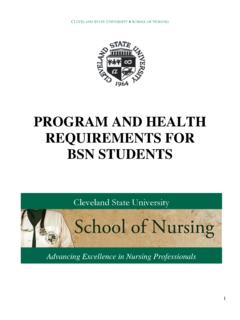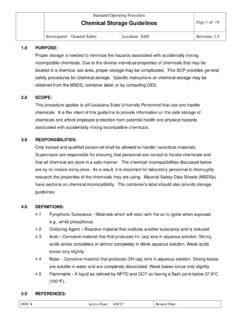Transcription of Standard Operating and Quality Assurance Procedures X-Ray ...
1 Standard Operating and Quality Assurance Procedures X-Ray Generating Equipment Office of Environmental Health and Safety Revised, 10/29/2015 Introduction The Cleveland State University Office of Environmental Health and Safety has developed the following Standard Operating Procedures (SOP) as an aide in maintaining compliance with regulations governing the registration and use of X-Ray generating equipment in the State of Ohio. Such regulations are established by the Ohio Department of Health s (ODH) Bureau of Radiological Health.
2 Scope This Standard Operating procedure addresses the purchase, receipt, use and removal of all X-Ray generating equipment by the individuals on the CSU campus. The type of equipment addressed by this SOP includes but is not limited to the following: luminoscope (non-medical unit), particle accelerator, diffraction, fluorescence, spectrophotometer, analytical, electron microscope, gauging, baggage unit/cabinet, radiographic, fluoroscopic, CT, tomographic, electron beam processor, electron beam welder, electron beam coater, cabinet irradiator, and dental units such as intraoral, cephalometric, TMJ, panoral and tomographic X-Ray tubes.
3 Responsibility Compliance with rules and regulations pertaining to X-Ray generating equipment as mandated by the ODH s Bureau of Radiological Health lies with each individual user of X-Ray generating equipment. The University Radiation Safety Officer (RSO) will have ultimate responsibility and authority to assure that these regulations are being followed. Purchase/Receipt Prior to purchasing any new piece of X-Ray generating equipment, interested individuals shall contact the RSO in writing, providing all pertinent information regarding the type of equipment needed.
4 This should include intended use, location, equipment description (see scope above) and proposed vendor. This correspondence shall be accompanied with a copy of the purchase requisition that contains instructions to coordinate installation with the Radiation Safety Officer and the RSO s phone number. The RSO shall process the paperwork required by the ODH Bureau of Radiological Health which adds the new unit(s) to the University s license. The RSO will inform users of established policies which address using new x -ray generating equipment and provide each with a copy of this SOP.
5 Upon receipt, the user shall ensure copies of all packing slips, technical data and Operating Procedures are forwarded to the RSO. Equipment Use Signage The areas in which X-Ray generating equipment are located shall be posted with signage informing those entering that X-Ray generating equipment is present. This signage bears the radiation symbol and has the words Caution X-Ray Radiation Authorized personnel only. A copy of the Notice to Employees from the ODH also shall be posted in/near the room. Operation Each user shall provide the RSO with a written copy of instructions detailing step- by-step operation of the equipment as well as a copy of the manufacturer s operations manual, if available.
6 Should any of the Operating Procedures be modified for any reason, the revised procedure should also be forwarded to the RSO. Dosimetry The main goal of the CSU Radiation Safety Program and Procedures for working with X-Ray Generating Equipment are to minimize exposure to radioactive materials, and to the radiation levels they may produce, to a level that is AS LOW AS REASONABLY ACHEIVABLE (ALARA). Various types of X-Ray generating equipment require the use of personal dosimeters/film badges by the operator. Many are designed and equipped with a series of internal safety features that automatically deactivate the X-Ray unit which eliminates the need for film badge monitoring.
7 Whether or not a film badge is required for use will be determined by the RSO after reviewing the operator s manual and proposed experiment. If film badges are required, each individual who operates an X-Ray generating device will be issued a film badge. The Office of Environmental Health and Safety replaces film badges on a quarterly basis and maintains a dosimetry report of all personnel issued a film badge. Each individual who is issued a radiation film badge shall be provided with an annual personal dosimetry report. Film badges cannot be removed from the Operating area for any reason and should never be worn off campus.
8 The Radiation Safety Office also has a limited number of spare badges which may be issued in emergency situations ( when individuals not normally issued a badge, such as maintenance personnel who must enter a radiation area to perform maintenance work). In accordance with provisions set forth in the Ohio Administrative Code 3701:1-38, the maximum permissible exposures for CSU personnel are: Maximum Permissible Dose (Annual) Dose Type REM Sieverts Total Effective Dose Deep Dose + Equivalent Committed Dose to Organs (non-eye) 50 Dose Equivalent to Eye 15 Shallow Dose Equivalent to skin or extremities 50 Declared Pregnant Women Embryo/Fetus General public Should an exposure report indicate an individual has received an exposure in excess of 20 mRem, the RSO will notify the individual as soon as possible.
9 The RSO will make every effort to identify the cause of the exposure and take corrective action to eliminate the source. All whole body exposures indicated in excess of 200 mRem for a reporting period will result in the RSO immediately halting further use of radioisotopes until the cause of the reported exposure is determined. In the event exposures in excess of levels set forth in the Ohio Administrative Code 3701:1-38-12 and 3701:1-38-13, the RSO will notify the Ohio Department of Health in writing within thirty days after learning of the overexposure. Corrective action may include, but is not limited to revising specific Standard Operating Procedures in an individual lab, having the X-Ray generating equipment evaluated by a manufacturer s service representative, and the use of additional shielding.
10 Exposure reports are available for individual review their values by making an appointment with the RSO. Upon receipt of a signed release, an individual may request a transfer of their exposure history to another facility by filling the appropriate release form. Training Prior to working with x- ray generating equipment all users shall be required to review information contained in this SOP, the operator s manual and any additional training material provided to them by the Office of Environmental Health and Safety. Verification that this training has been completed will be recorded on the Documentation of Radiation Training of Individuals form found as Appendix A.


















